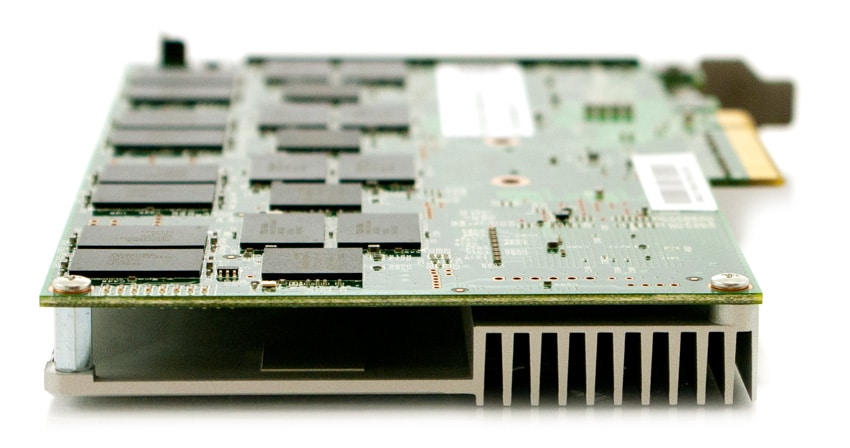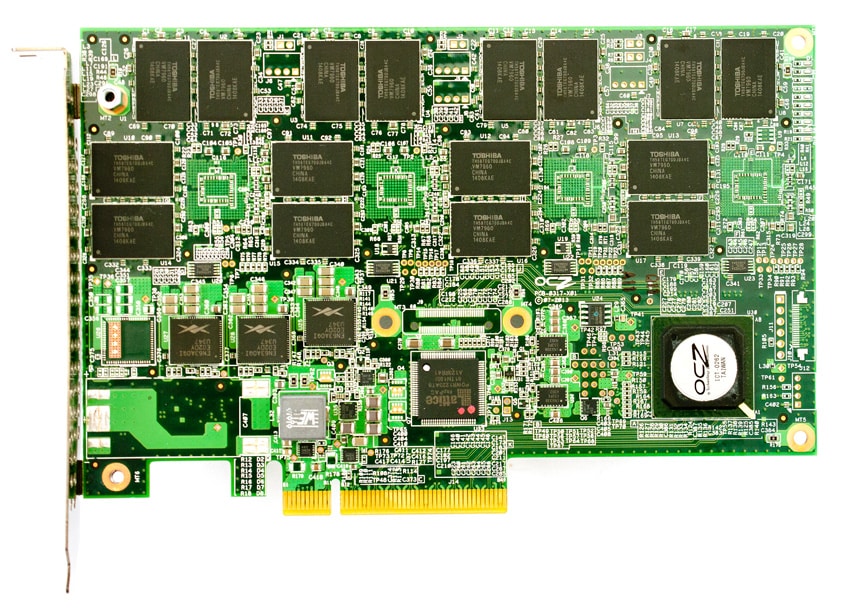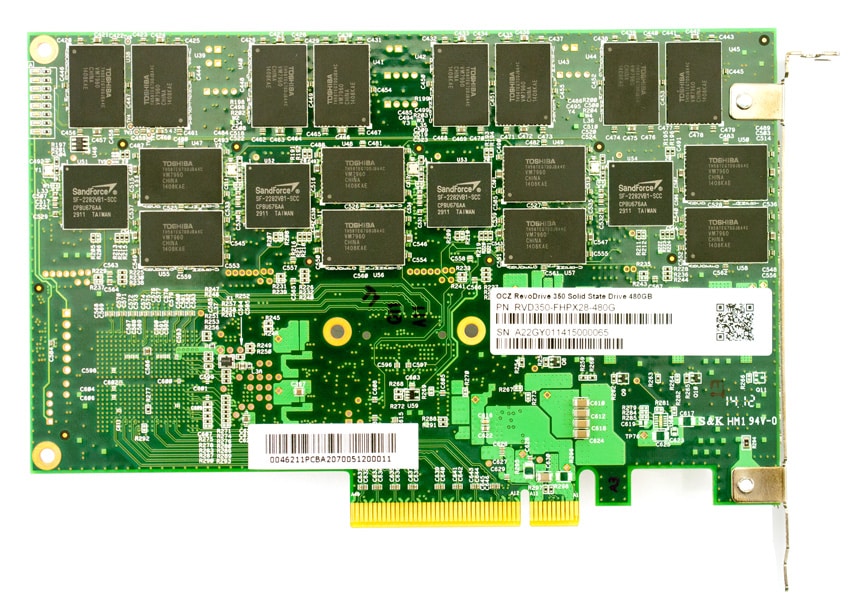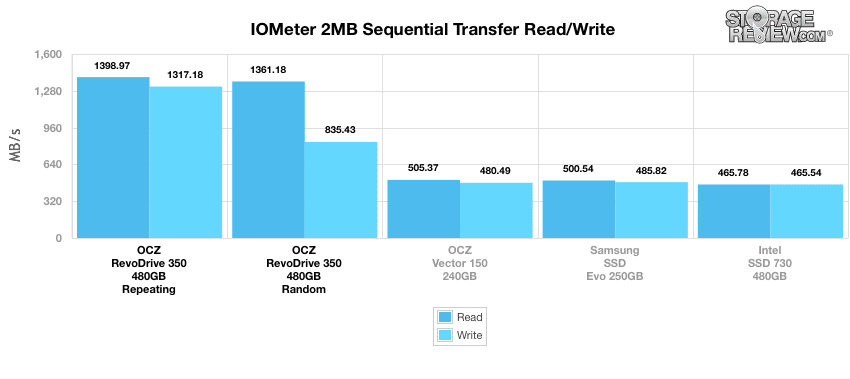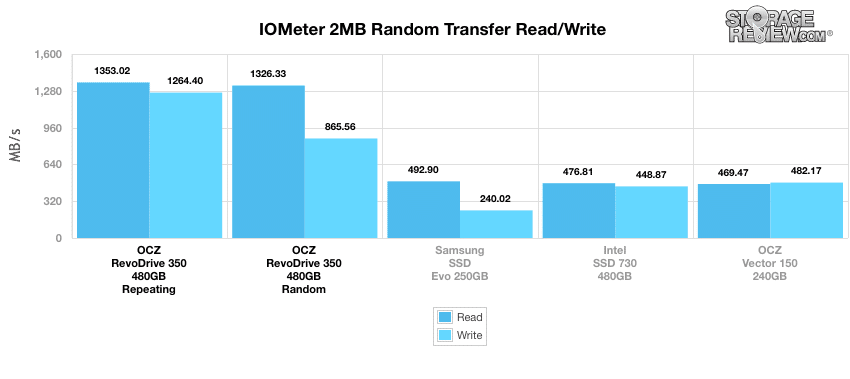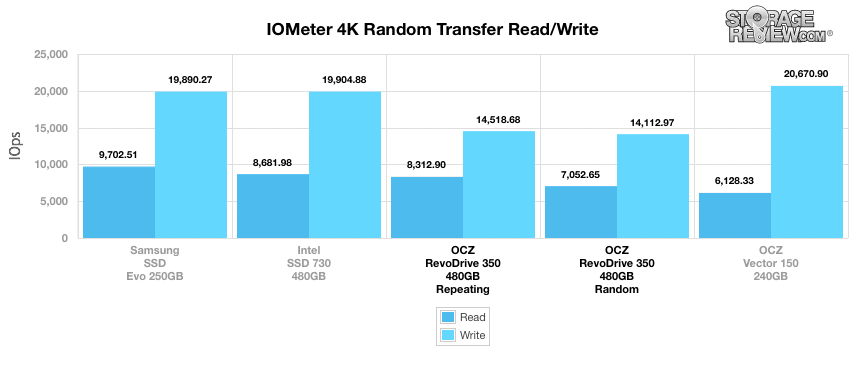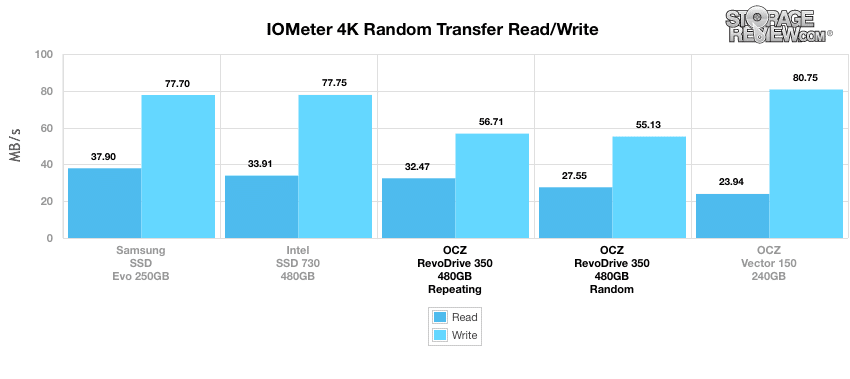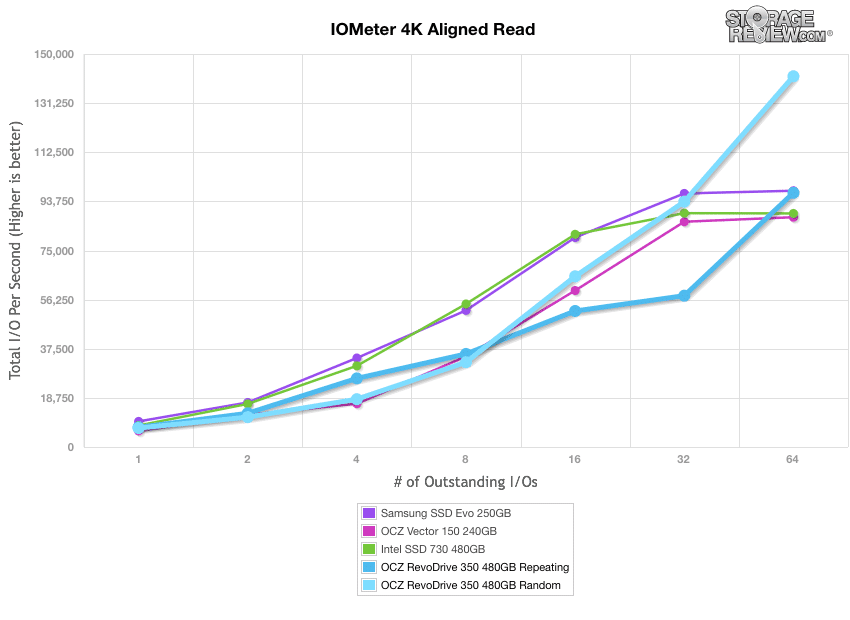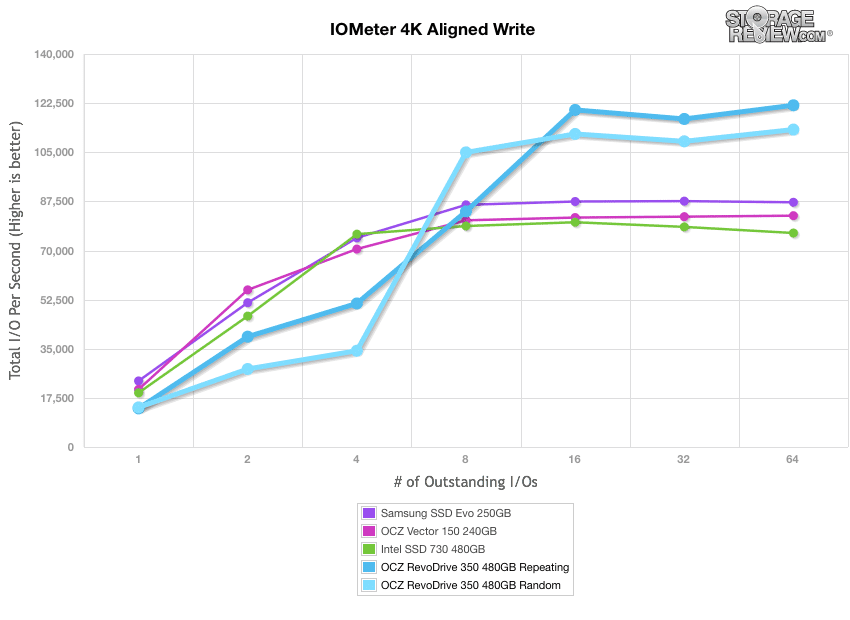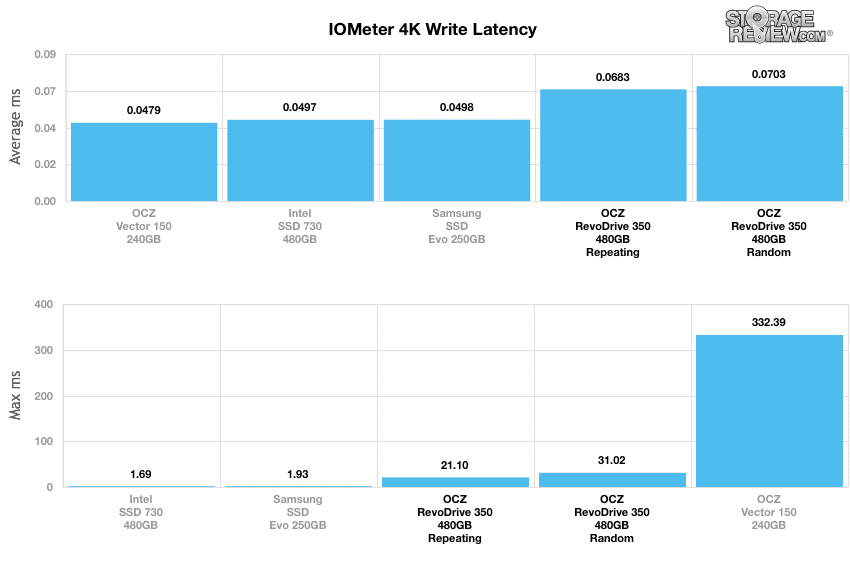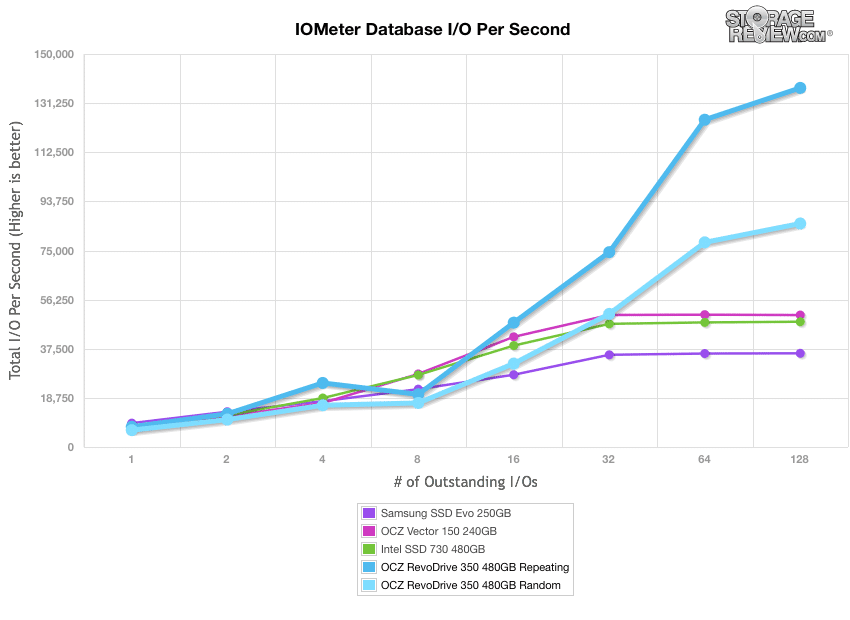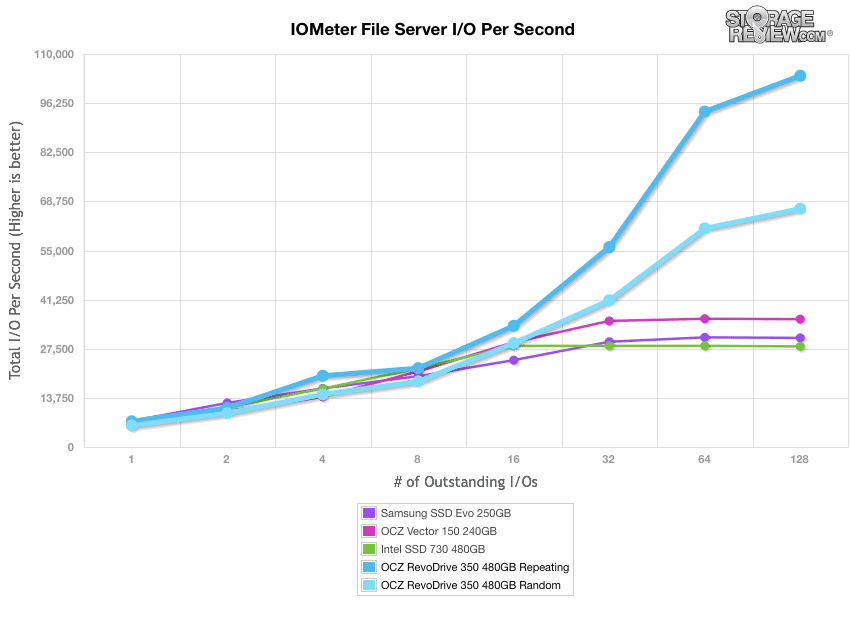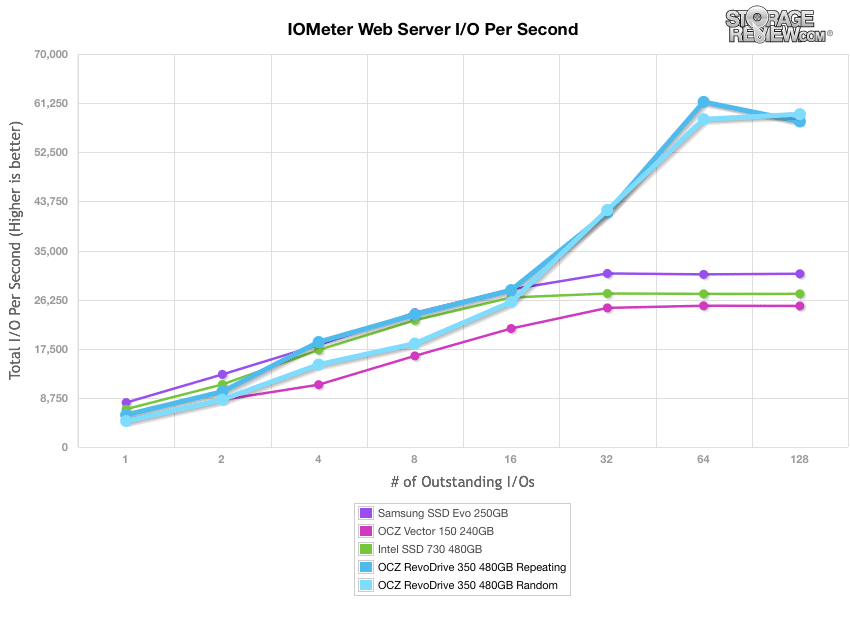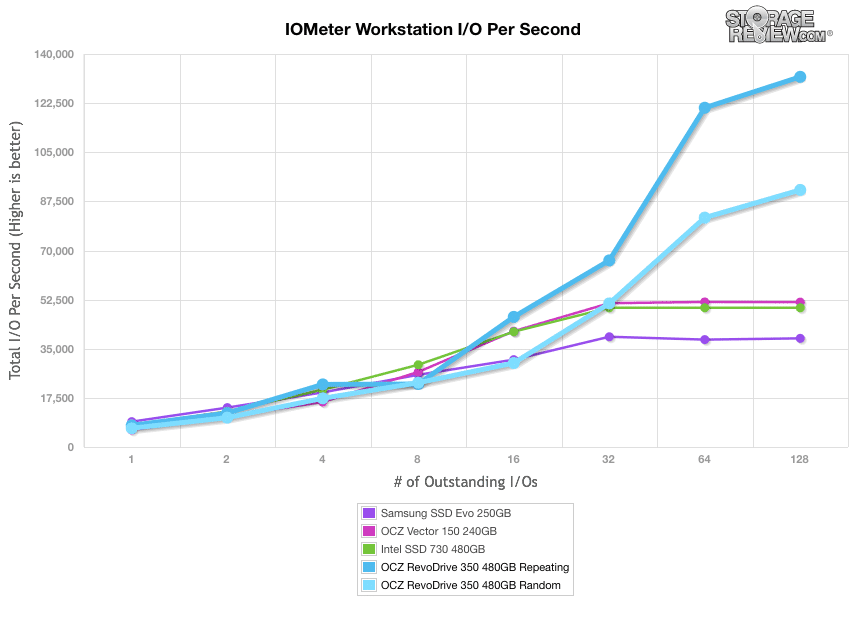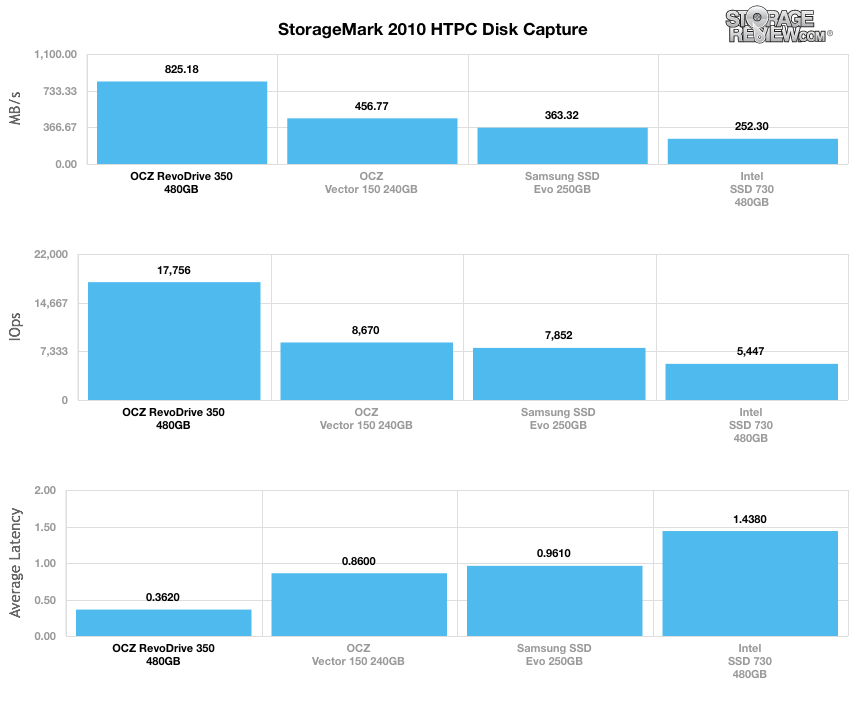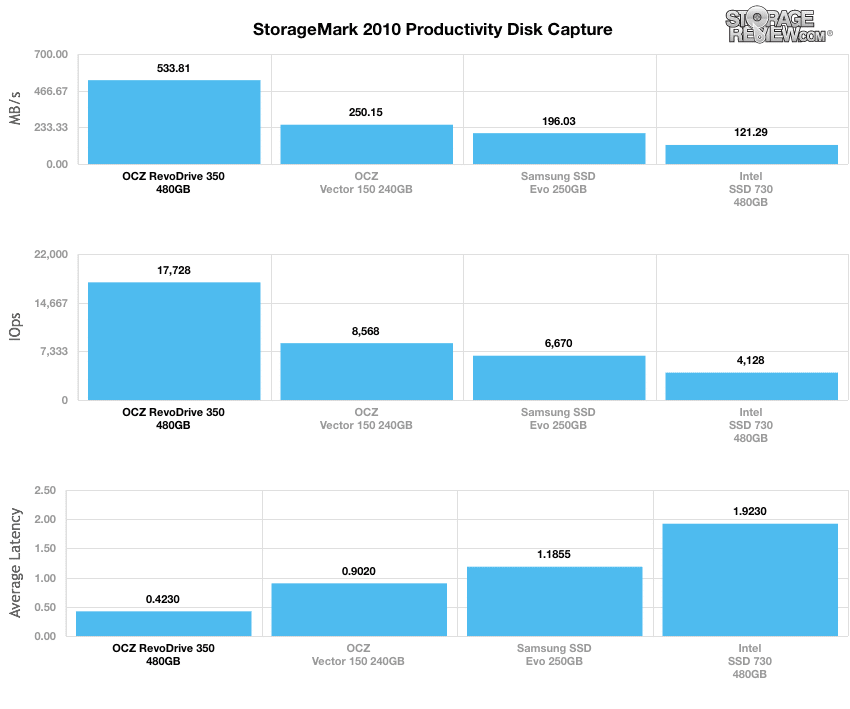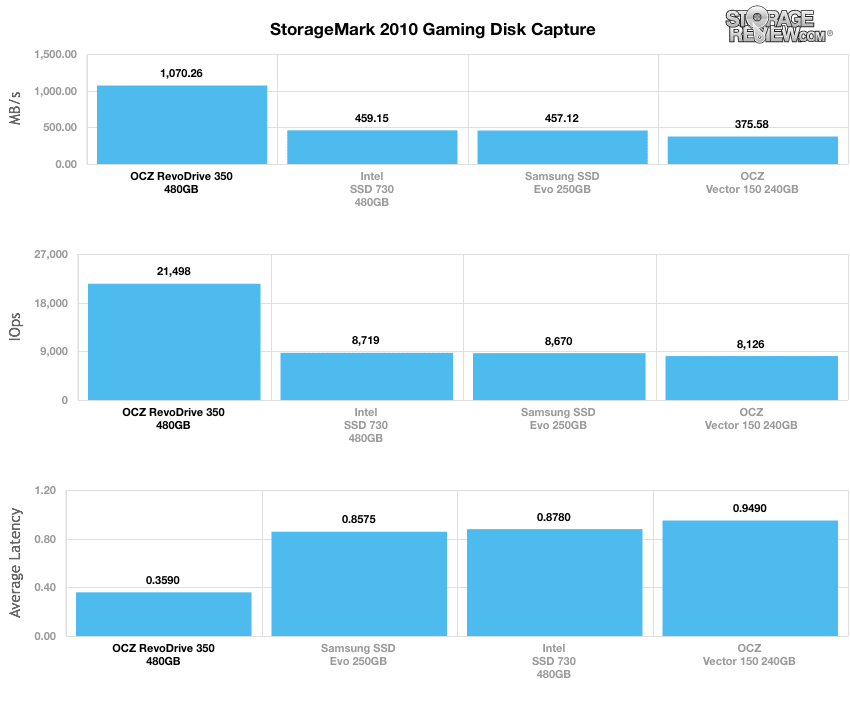
The OCZ Storage Solutions RevoDrive 350 is the latest edition of its RevoDrive family of enthusiast PCIe SSDs. The RevoDrive 350 is redesigned from the ground up with updated drivers to enable maximum performance and efficiency as well as taking advantage of new hardware design. The RevoDrive 350 is a PCIe integral storage solution, which is often used by creative professionals, enthusiasts and others who are looking to get around bandwidth limits that face traditional SSDs (i.e. 6Gb/s). We reviewed its predecessor–the OCZ RevoDrive 3 X2–a few years ago and were incredibly impressed with the results. We expect more of the same with the OCZ RevoDrive 350 drives (and then some!), as the 350 is specced to boast read speeds upwards of 1800MB/s, writes of 1700MB/s and 4K random write IOPS of 140,000 for the 480GB/960GB models. These quoted numbers by OCZ are by in large the fastest seen we’ve seen yet for any client PCIe SSDs from any brand of consequence, setting a new bar for performance.
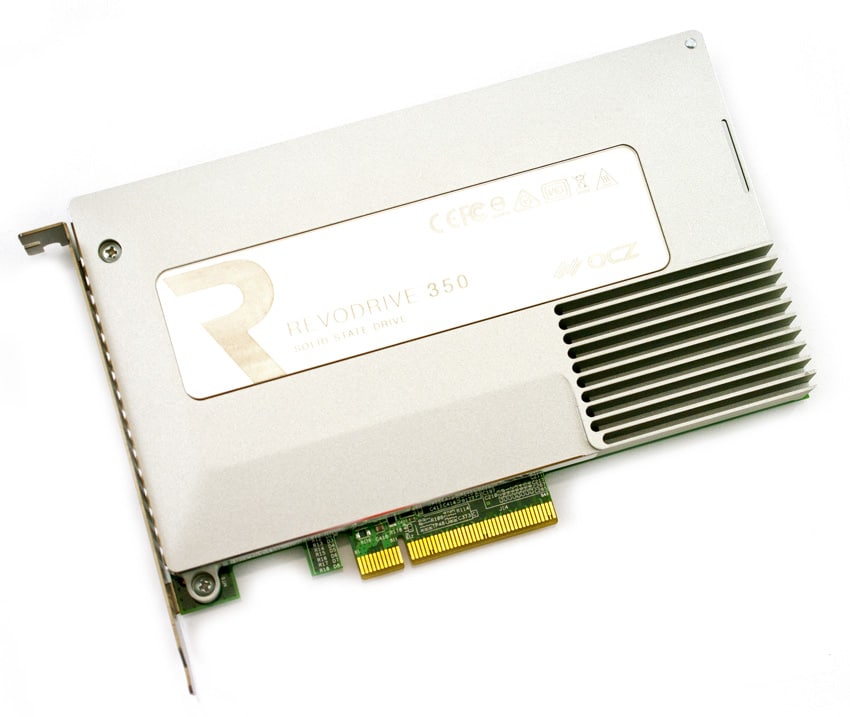
To attain these impressive performance numbers, under the RevoDrive 350's hood lay SandForce SF-2282 processors (x2 on the 240GB model and x4 on 480GB/960GB models) with Visualized Controller Architecture (VCA) 2.0 Technology to tie them together and 19nm Toshiba MLC flash. The Toshiba Flash memory is built in-house thanks to the new ownership of OCZ Storage Solutions. The new OCZ drive also is equipped with a new integrated heatsink, which is a vital part to offering a more stable and cooler thermal environment.
The OCZ RevoDrive 350 drives come in capacities of 240GB ($529.99 MSRP), 480GB ($829.99 MSRP), and 960GB ($1,299.99); all drives are inclusive of a three-year warranty. We have the 480GB unit for this review.
RevoDrive 350 Specifications
- Interface: PCI Express Gen 2 x8
- Performance:
- 240GB: 1000MB/s max read; 950MB/s max write; 45,000 max Random Read IOPS; 80,000 max Random write IOPS
- 480GB: 1,800MB/s max read; 1,700MB/s max write; 90,000 max Random Read IOPS; 140,000 max Random write IOPS
- 960GB: 1,800MB/s max read; 1,700MB/s max write; 135,000 max Random Read IOPS; 140,000 max Random write IOPS
- Controller: SandForce SF-2282 processors (x2 on the 240GB model and x4 on 480GB/960GB models)
- NAND: 19nm Toshiba MLC flash
- Encryption: 128-bit AES- Compliant
- Power consumption:
- Idle: 9.5W
- Active: 14.0W (480GB)
- Warranty: 3 years
Design and build
Right away, you will notice a huge step forward in design compared to its predecessor, the RevoDrive 3 X2, with its new sleek looking metal enclosure, which acts as a heat sink. This new build allows for more stable and cooler thermal SSD environment, undoubtedly giving the RevoDrive 350 better performance as well as an extended lifetime. This is all the more important in PCs as PCIe slots rarely receive the airflow required to keep attached components cool.
The enclosure itself has been secured on the card with two Philips head screws on the front and two on the side/back. The RevoDrive 350 is a very solid feeling device when handled, again showing good steps forward in engineering.
When the front enclosure is removed, you will see that the OCZ tightly packed with the 19nm Micron NAND flash (its predecessor using 25nm).
The interface of the RevoDrive 350 is the 8x PCIe Gen 2 connector, boasting up to 1,800MB/s of bandwidth. It is powered by the connector as well, so users don’t have to attach it to an additional power source.
Enterprise Application Performance Analysis
StorageReview’s Microsoft SQL Server OLTP testing protocol employs the current draft of the Transaction Processing Performance Council’s Benchmark C (TPC-C), an online transaction processing benchmark that simulates the activities found in complex application environments. The TPC-C benchmark comes closer than synthetic performance benchmarks to gauging the performance strengths and bottlenecks of storage infrastructure in database environments. Our SQL Server protocol uses a 440GB (1,500 scale) SQL Server database and measures the transactional performance and latency under a load of 15,000 virtual users.
The RevoDrive 350 clearly isn't intended to be used within a server for heavy workloads, but with the power it promises there are many times where the 350 will work itself into light-enterprise use cases like small databases and analytics either within a workstation or server environment. We compared the OCZ RevoDrive 350 to its predecessor, the OCZ RevoDrive3 X2 in SQL Server Output. The RevoDrive 350 had a much less average latency with 9ms compared to the RevoDrive3 X2's 17ms. In our transactions per second (TPS) benchmark, however, results were virtually identical. As with enterprise SQL testing though it's responsiveness that matters and the new 350 clearly wins out.
Consumer Synthetic Workload Analysis
All consumer SSD benchmarks are conducted with the mid-range StorageReview Consumer Testing Platform. The comparables used for the review below include:
- OCZ Vertex 150 SSD (240GB, Indilinx Barefoot 3 BF3-M10, 19nm MLC NAND, SATA)
- Samsung SSD 840 EVO (250GB, 400MHz Samsung 3-core MCX controller, Samsung 1x nm Toggle NAND Flash, SATA)
- Intel SSD 730 (480GB, Intel PC29AS21CA0 controller, 20nm Intel MLC NAND, SATA)
All IOMeter figures are represented as binary figures for MB/s speeds. It should be noted that all of the comparables are SATA-based.
Our first test measures 2MB sequential performance, and as expected, the OCZ RevoDrive 350 wiped the floor against SATA competition, measuring blistering repeating/random read and write speeds of 1399.0/1361.1MB/s and 1317.2/835.4MB/s respectively. The OCZ Vector 150 240GB took second place in the read column with 505.4MB/s while the Samsung SSD Evo was second in the write column with 485.8MB/s.
In our next test looking at 2MB random transfer performance, the OCZ RevoDrive 350 posted repeating/random speeds of 1353.0/1326.3MB/s read and 1264.4/865.6MB/s write.
Switching to smaller 4K random transfers, the OCZ RevoDrive 350 was momentarily brought back down to reality measuring repeating/random speeds of 8,312.9/7052.6IOPS read and 14,518.6/14,112.9IOPS write, which ranked at the bottom of the pack.
In our next test, we shift to a 4k random workload with 100% read activity that scales from 1QD to 64QD. In this setting the OCZ RevoDrive 350 Random took top place by a large margin, scaling from 7,212.6IOPS up to a massive 141,487.2IOPS.
Shifting focus to write activity, the OCZ RevoDrive 350 continued to dominate, measuring 14,116.2IOPS at QD1 and peaking at just over 113,084IOPS at QD64 Random.
When comparing average write latency between each mainstream consumer SSD, the OCZ RevoDrive 350 in the random configuration ranked at the bottom of the pack with an average latency of 0.07ms and a peak latency of 31.02ms. Repeating didn’t fare any better with 0.068ms on average and a peak of 21.1ms.
Our last series of synthetic benchmarks compare the hard drives in a series of server mixed-workloads with a queue depth of ranging from 1 to 128. Each of our server profile tests has a strong preference towards read activity, ranging from 67% read with our database profile to 100% read in our web server profile. In all of our mixed workloads, the OCZ RevoDrive 350 dominated the pack, which was again expected from a PCIe form factor SSD.
The first is our database profile; with a 67% read and 33% write workload mix primarily centered on 8K transfer sizes. In the test, OCZ RevoDrive 350 outperformed all of the drives by an incredibly large margin, with the Repeating configuration almost tripling that of the Vector 150.
The next profile looks at a file server, with 80% read and 20% write workload spread out over multiple transfer sizes ranging from 512-byte to 64KB. The OCZ RevoDrive 350 in Repeating configuration delivered QD1 throughput just behind the Samsung drive; however, it more than tripled its IOPS competition by Q128.
Our web server profile is read-only with a spread of transfer sizes from 512-byte to 512KB. The OCZ both RevoDrive 350 configurations once again drive provided performance at the top by a very large margin.
The last profile looks at workstation activity, with a 20% write and 80% read mixture using 8K transfers. In QD1, the OCZ RevoDrive 350 drive (Repeating) started at the 7,720IOPS mark but ended up with an IOPS that doubled its comparables by Q128, with the Random configuration close behind.
Consumer Real-World Benchmarks
For the average consumer, trying to translate random 4K write speeds into an everyday situation is pretty difficult. It helps when comparing drives in every setting possible, but it doesn't exactly work out into faster everyday usage or better game loading times. For this reason we turned to our StorageMark 2010 traces, which include HTPC, Productivity, and Gaming traces to help readers find out how a drive might rank under these conditions.
The first real-life test is our HTPC scenario. In this test we include: playing one 720P HD movie in Media Player Classic, one 480P SD movie playing in VLC, three movies downloading simultaneously through iTunes, and one 1080i HDTV stream being recorded through Windows Media Center over a 15 minute period. Higher IOps and MB/s rates with lower latency times are preferred. In this trace we recorded 2,986MB being written to the drive and 1,924MB being read.
In our HTPC profile, the OCZ RevoDrive 350 boasted pretty incredible results posting an IOPS of 17756.4, a max transfer speed of 825.18MB/s and an average latency of only 0.362ms
Our second real-life test covers disk activity in a productivity scenario. For all intents and purposes this test shows drive performance under normal daily activity for most users. This test includes: a three hour period operating in an office productivity environment with 32-bit Vista running Outlook 2007 connected to an Exchange server, web browsing using Chrome and IE8, editing files within Office 2007, viewing PDFs in Adobe Reader, and an hour of local music playback with two hours of additional online music via Pandora. In this trace we recorded 4,830MB being written to the drive and 2,758MB being read.
In our Productivity trace, the OCZ RevoDrive 350 continued its dominance posting 533.8MB/s, 17,727.9IOPS, and an average of 0.423ms.
Our third real-life test covers disk activity in a gaming environment. Unlike the HTPC or Productivity trace, this one relies heavily on the read performance of a drive. To give a simple breakdown of read/write percentages, the HTPC test is 64% write, 36% read, the Productivity test is 59% write and 41% read, while the gaming trace is 6% write and 94% read. The test consists of a Windows 7 Ultimate 64-bit system pre-configured with Steam, with Grand Theft Auto 4, Left 4 Dead 2, and Mass Effect 2 already downloaded and installed. The trace captures the heavy read activity of each game loading from the start, as well as textures as the game progresses. In this trace we recorded 426MB being written to the drive and 7,235MB being read.
In our read-intensive Gaming trace, OCZ RevoDrive 350 produced an incredible 1,070.3MB/s and 21497.5IOPS with an average latency of 0.36ms, essentially doubling the performance of the SATA-based comparables.
Conclusion
Flash technology is simply getting too fast for the SATA interface, as it can’t handle the technology’s growing potential due to hardware limitations. To remedy this, businesses and professionals–who are able to spend a bit more money–are looking to the PCIe form factor, which does not have SATA’s inherent bandwidth restrictions. The OCZ RevoDrive 350 definitely takes advantage of its hardware, as this enthusiast and enterprise-grade SSD uses a PCI Express Gen 2 x8 interface and is quoted to deliver upwards of 1,800MB/s. In addition, this impressive SSD comes in capacities of 240GB, 480GB, and 960GB and is equipped with SandForce SF-2282 processors.
Diving into its performance, there were really no surprises after seeing the results of our benchmarking tests; just like its predecessor. It’s not really fair to compare it to its SATA III-based comparables, but it is helpful to demonstrate scale, and thus we included them into our tests. That said, the OCZ RevoDrive 350 showed incredible performance across the board, consistently ranking at the top of our charts. We expected this going forward to a degree; however, with such staggering comparative margins in single-user benchmarks, such as the sequential 2MB IOMeter test and the Gaming real-world benchmark as well as with real-life scenarios, it was hard not to get a bit wide-eyed. In these tests, the RevoDrive 350 completely wiped the floor with its competition, the card definitely delivers on all cylinders.
The main complaint many will have however is price, the OCZ drive will be a little hard to swallow for some. If you're a media professional though, even the $1,299.99 price tag for the 960GB model, doesn't seem that bad when weighed against the productivity gains. There are of course other ways to get at this performance issue, you could buy a few SSDs for the price of one RevoDrive 350 of the same capacity and RAID them together. The advantage of the RevoDrive 350 (besides its overwhelming performance benefits) though is its simple, single PCIe plug-and-play configuration with no additional hardware needed.
It's also worth noting that while client PCIe is a niche space that's largely ignored by storage vendors, especially now with the backing of Toshiba, OCZ's drive stands out from the also-rans in the consumer flash space from a service and support perspective too. The other solutions typically just slap a single thin form factor SSD onto a PCIe board, but that doesn't take advantage of multiple controllers or sophisticated architecture that can squeeze out additional performance. The closest comparable is the Fusion-io ioFX, which while brilliantly designed, still carries a street price of $1500 for their 420GB iteration while the 1.6TB is $5400.
Pros
- Incredible performance
- Solid Design
- Easy-to-deploy PCIe interface
Cons
- Limited top-end capacity
Bottom Line
The OCZ RevoDrive 350 is a beast of an SSD with performance that will suit the needs of light enterprise, hardcore gamer, creative pro or power enthusiast. There simply aren't a lot great options when it comes to workstation PCIe storage but thankfully with OCZ re-committing, the RevoDrive 350 stands out as the De facto leader of the pack at its capacity points.

